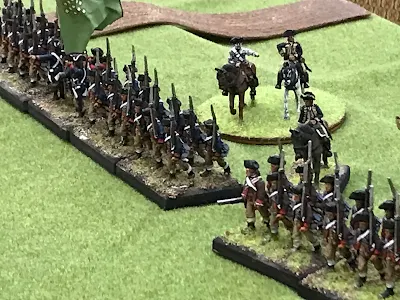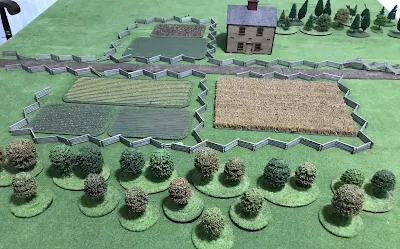 |
| General Greene directing his Continental line. |
A brief pause on my fighting the Camden campaign. I needed to do a little bit more research on the Battle of Hanging Rock and then up popped club game night. Due to medical reasons I hadn't been to a club night in almost a year. But Earl insisted it would be good for me to go; and better for all if I put on a game. Warren kindly offered to drive so we were off and running.
 |
| Game set up. John and Byron on left and Warren and Mike on right. |
My game would be based on the Battle of Hobkirk Hill South Carolina in April 1781. Its a close run action which saw a mostly Loyalist army take on General Nathaniel Greene's army. In addition I wanted to run it remember a friend, Chase who recently passed away suddenly. He had been painting up an army to refight this battle and we exchanged information on how best to fight it and uniform details of the regiments present. So I thought how best to remember him.
After the Battle of Guildford Courthouse (March 1781) American General Nathaniel Greene moves his army south to South Carolina to drive out the British occupation forces. While Cornwallis marched to Virginia, Lord Rawdon is left with a mainly loyalist force to defend the colony. In April Greene takes position outside the British post at Camden with his main army of Continental regiments while his light troops raid smaller outposts. Rawdon, although outnumbered decides to attack Greene before he can call in militia support.
 |
| Crown Forces on left and Continental line on right. |
The table is set up. On the left side Lord Rawdon's forces marching towards Greene's line. Crown Forces have skirmishers out front, followed by 63rd Regiment, New York Volunteers and Kings American Regiment. Second line Volunteers of Ireland, South Carolina Royalists and Royal Artillery. Reserve are Major Coffins Loyalist Dragoons (i.e. mounted Infantry). Greene's army on the right side. Light Infantry skirmishing in front are Maryland/Virginia light companies and Kirkwood's Delaware. On the ridge line from viewer are 2nd Maryland, 1st Maryland, 4th Virginia and 5th Virginia Continental regiments. In reserve are Lt. Col. Washington's 3rd light dragoons, two Continental Artillery guns and a North Carolina militia regiment with some attached Riflemen. They are not placed on the table untill the second move and hidden from the British players.
 |
| Maryland Continental line. |
Greene's line is on a long ridge. A single road heading to the town of Camden divides the table. There is a stream on the side of table which is ford able by infantry and cavalry (at a penalty) but not artillery. There are scattered trees but a very open growth which does not give cover or block sight.
 |
| Light Infantry screening advancing Crown Forces |
Crown Forces advancing on the Continental line. Greene orders his light troops to hold off the enemy while his regulars form up They are to buy time for reinforcements to arrive.
Kirkwood's Delaware and the Marylanders light infantry companies fire and retire giving Greene time to organize his line and causing casualties among the advancing loyalists.
Coffin's loyalist dragons ride down the Maryland/Virginia light infantry. They pursue them up to the main Continental line where the lights break and rout off the field. Alas! As happens too often the enthusiasm of the cavalry carry them too far and the two Virginia regiments wipe out the handful of dragoons. Poor Major Coffin is left alone!
At this point the Continental artillery, North Carolina militia and Rifles arrive on the field. A rather nasty surprise. Historically Rawdon attacked because a deserter told him there was no militia and no artillery present.
On the British right flank the advancing line steadily drives the Delaware lights back to the ridge.
Coming off the ridge the two Virginia Continental line regiments with the North Carolina Rifle regiment march to out flank the advancing red coats.
The King"s American Regiment and South Carolina Royalist swing to their left to counter it. Rawdon pushes forward to flank the Continentals on the ridge line. The Virginia line attacks the loyalist regiments. Heavy casualties for the King's American to break. All that us now holding the flank is the SC Royalist regiment.
The New York Volunteers and 63rd Regiment attack the Ridge. They rout the 2nd Marylanders, capturing their colors! The NC militia fail moral and routs off the ridge too! All that is left is the 1st Marylanders and a artillery battery.
Waiting in reserve is Lt.Col. William Washington and his 3rd Continental light Dragoons. They charge forward and crash into the NYV. In the melee the loyalist break, their colonel killed and colors lost. The 63rd (who have lost over 50%) also retreats.
At this point the Crown Forces throws in the towel. The Virginia regiments with the rifles and a gun are sweeping up the left flank while the 1st Marylanders and a gun hold the ridge. All that is left of his army is the Volunteers of Ireland to cover the retreat. A disastrous day for the Crown and Greene finally gets a victory.
Thank you very much to Warren, Mike, John and Byron for a great game and a very fun evening. I hope you all enjoyed it. Curiously enough as it was set up for my friend Chase it ended with the dramatic charge if the 3rd light dragoons. That was his favorite Rev War unit so I hope in some small way he enjoyed it.




























